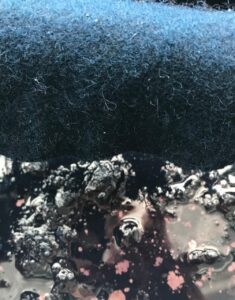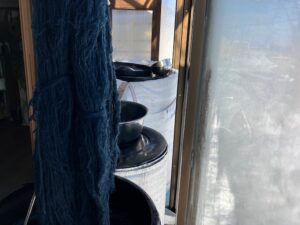
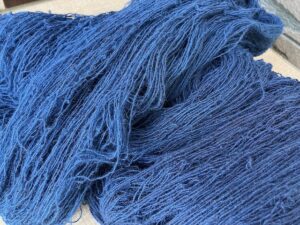


A record of 100 days from preparation to dyeing of Sukumo Ai in 2023 summer
2017年、庭にウォードを直播、プランターにエゾタイセイの種をまき、2018年春に庭に移植し、栽培した。時々、布に葉を挟んで、その上から石で葉を叩いて、葉の汁を布に染めつけ、インジゴ色素の含有を確認した。収穫した葉を潰してウォードボール作り〜野外で発酵、秋に納屋に並べ、発酵ー熟成させた。2019年夏〜秋にウォードボールを砕き、水分を加えて発酵させ、すくもにした。2020年〜2022年まで、これを繰り返し3kgできた。
2022年9月、出来たウォードすくも400gを灰汁と小麦麩で新しい容器に仕込み、発酵させた。
2日後、液面に酸化したインジゴによる紫色の膜が現れ、液色が緑色の還元色になったので、7.5Lのステンレスポットに移して、灰汁を加えて6Lに嵩上げした。翌日染色、布が還元色の緑色になり、取り出して酸化、藍色に染まった。いつもの甘く明るいウォードの藍色である。
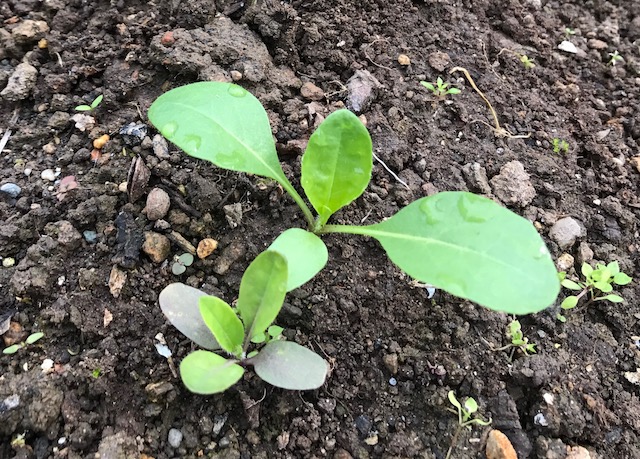
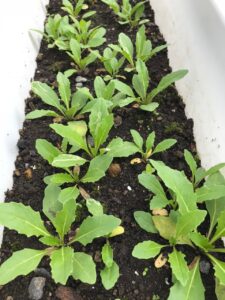
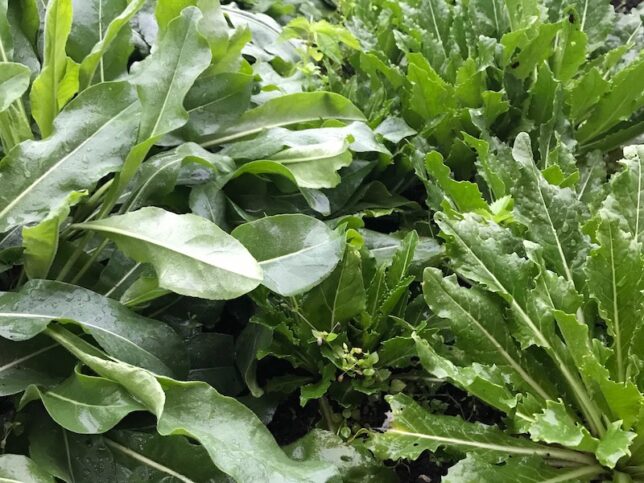

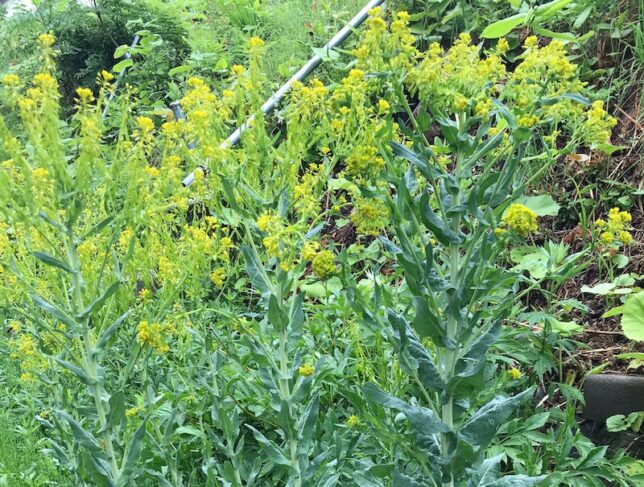
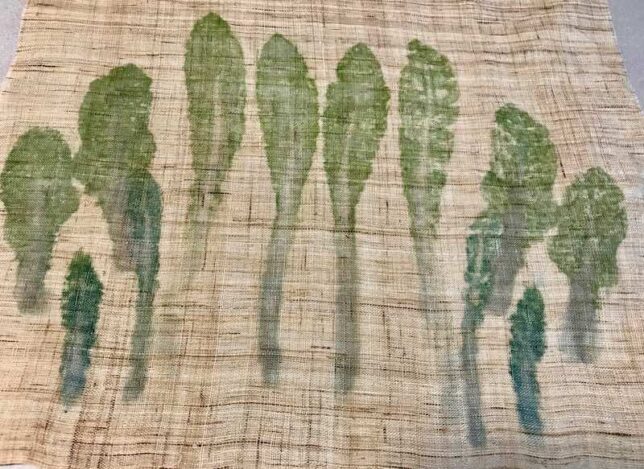
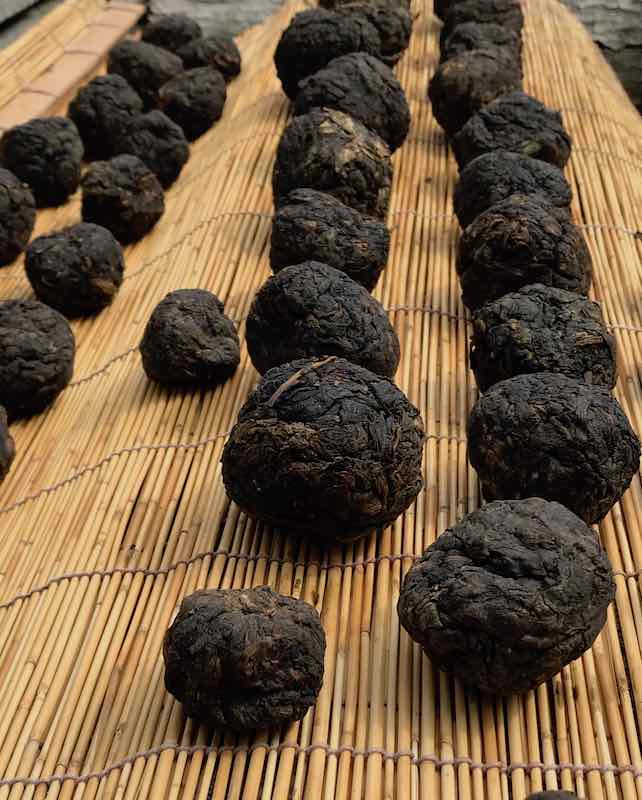
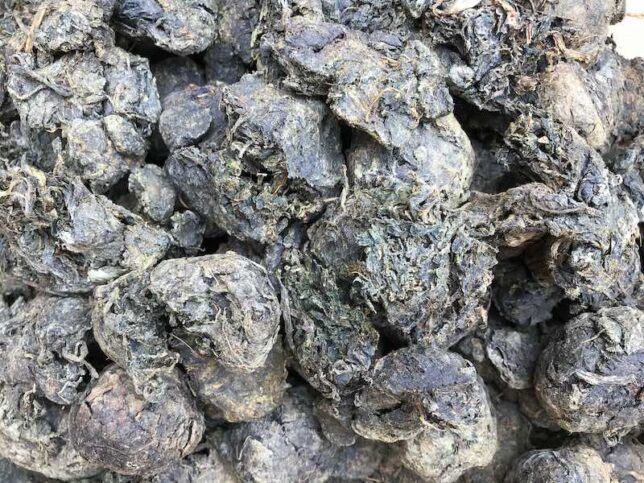
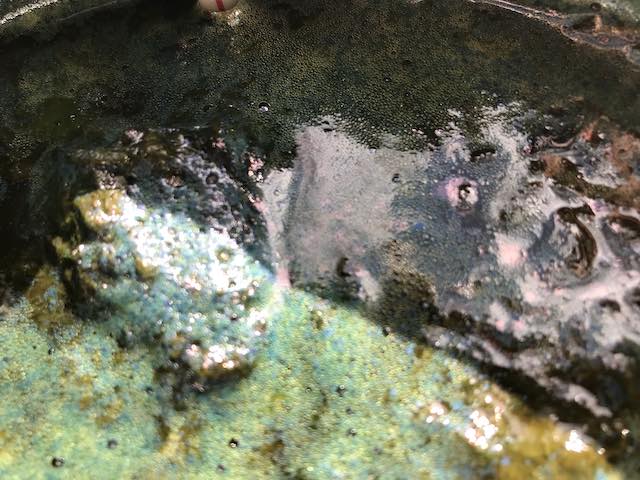
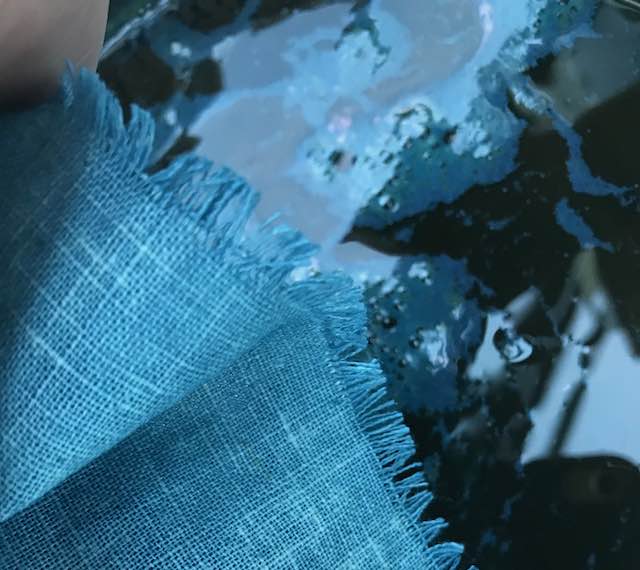
インドアイ乾燥葉パウダーの活用:2000年6月にインドアイ乾燥葉パウダーを購入、小樽の工房で試験染、東京・青山のGEICでの定期ワークショップでは、ステンレスボールにパウダーを入れ、水を加え、攪拌、放置、30分ぐらいで藍建液のように液面全体が藍色から紫色の泡で覆われ、染色可能であることを確認、みんなでワクワクして絹やウール、麻を藍染した。
2010年から琉球藍に灰汁と小麦麩で発酵させ、2013年から並行してインド藍靛の灰汁建を始めた。藍靛の灰汁建液に、インドアイ生葉を水に1日浸漬した液を加え、翌日微生物の活性を確認した。
2015年3月、インドアイの畑と藍製造所で乾燥葉を確認して、乾燥葉パウダーを購入、すくも藍発酵建の古い200L液に加えて、発酵が強くなり、藍染、色をを確認した。次にインド藍靛の藍発酵建液100Lの仕込みに使い、麻布、綿糸、原毛それぞれ1kgを染色した。
これらの経過と分析による研究が2021年と今年で2本の共同研究論文になりました。
2020年北方のいろ映像ワークショップ「2種類の藍染料の仕込みから発酵、染色」や、天然染色ノート2021「発酵染」に、活用方法を掲載しています。
「Indigofera tinctoria L.の葉の粉末は、微生物群集の急速な移行を誘導することにより、藍の還元の開始を促進する」
著者:Helena Lopes, Zhihao Tu, Hisako Sumi, Isao Yumoto,
発行: 国際ジャーナル”フロンティア 微生物学部門(非営利)
以下のURLから無料ダウンロードできます。
Regarding the use of Indigofera tinctoria dried leaf powder, I used it for indigo dyeing for the first time in 2000 and made it public at the workshop.
Since 2015, this joint research paper has been the result of a number of indigo fermentation projects and ongoing trials to increase the activity of microorganisms.
Natural Dyeing Note 2021 “Fermented dyeing” (booklet with dye sample clothes) and Kindle version shows how to use it.
“Indigofera tinctoria L. leaf powder promotes initiation of indigo reduction by inducing of rapid transition of the microbial community”,
by Helena Lopes, Zhihao Tu, Hisako Sumi, Isao Yumoto, published in Frontiers in Microbiology, section Extreme Microbiology.
To view the online publication, please click here:
http://journal.frontiersin.org/article/10.3389/fmicb.2022.957809/full?&utm_source=Email_to_authors_&utm_medium=Email&utm_content=T1_11.5e1_author&utm_campaign=Email_publication&field=&journalName=Frontiers_in_Microbiology&id=957809
This article is an open access publication
Utilization of Indigofera tinctoria dried leaf powder: Bought Indigofera tinctoria dried leaf powder in June 2000, test dyeing at atelier in Otaru, regular workshop at GEIC in Aoyama, Tokyo. I left it. After about 30 minutes, the entire liquid surface was covered with indigo to purple bubbles like indigo vats, confirming that it was possible to dye silk, wool, and linen with excitement.
Since 2010, I have been making the fermented indigo vat using the precipitated indigo of Strobilanthes cusia with lye and wheat bran. Indigofera tinctoria fresh keaves immersed in water for 1 day was added to 100 L of indigo cake lye vat, and microbial activity was confirmed the next day.
In March 2015, I visited the field of Indigofera tinctoria and the manufacturing process of indigo cake and dry leaf powder, purchased each, the old fermented sukumo vat 200L, the paste of leaf powder and water added to indigo vat In addition, two days later, the fermentation became stronger and the indigo dyed color was confirmed. Used to prepare Indigo cake 100L vat and dyed 1kg each of ramie, cotton and wool.
The above progress and research based on the analysis of the fermented liquid have become two joint research papers in 2021 and this time.
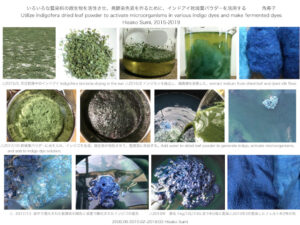
絹真綿はセリシンが残っていて、インジゴと相性が良い。染めた後、絹真綿をよく酸化させる。さらに染めと酸化を繰り返した後、水にしばらく浸ける。その後、2〜3回、ぬるま湯で濯ぐ。染めた藍色は水に戻らない。日向で短時間で乾燥させる。
Floss silk has sericin remaining and is compatible with indigo.
After dyeing, it is well oxidized, dyed and oxidized repeatedly, and soaked it in water. And then, rinsed it with lukewarm water. The dyed colour did not return to water. Dry in the sun in a short time.
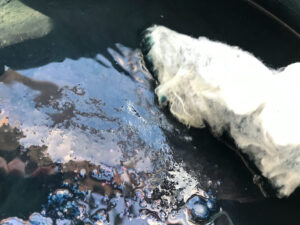
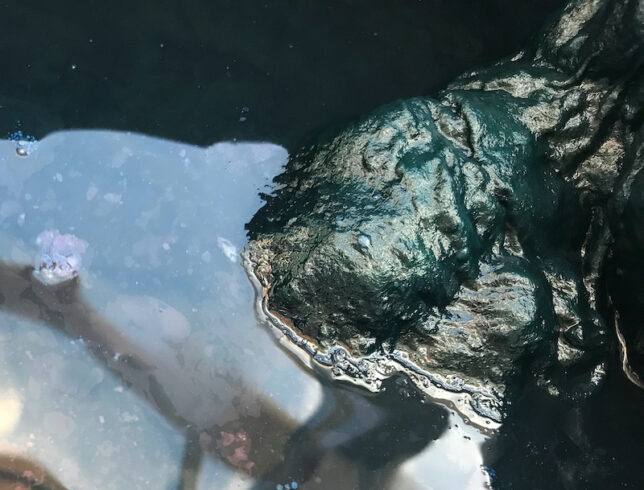
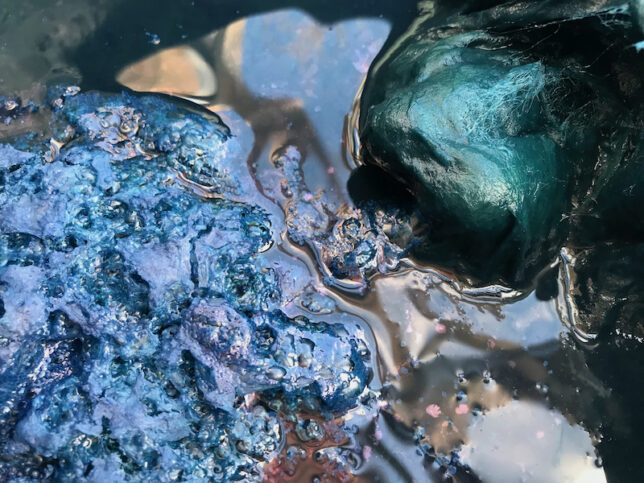
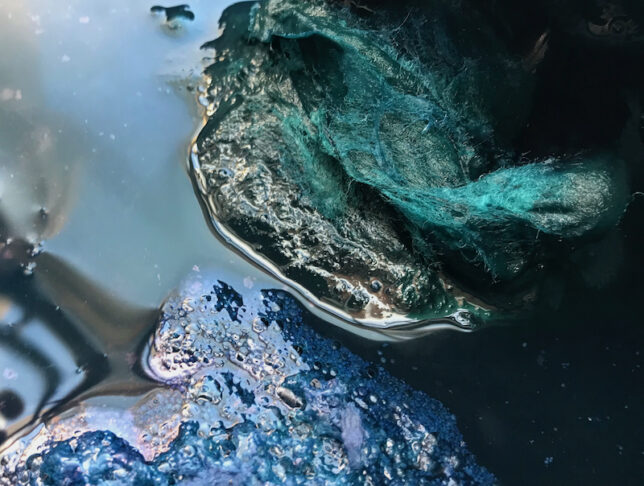
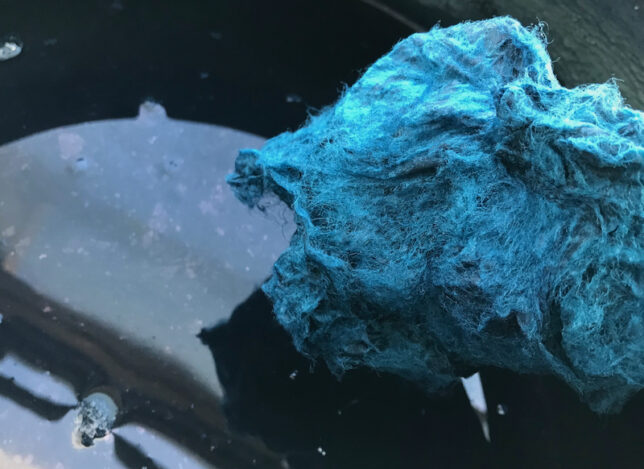
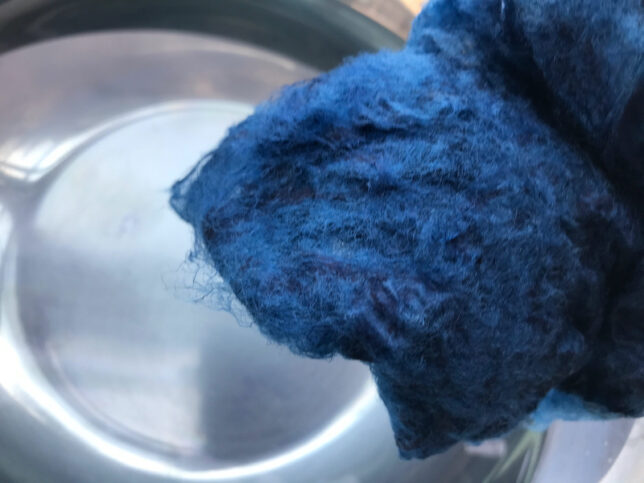
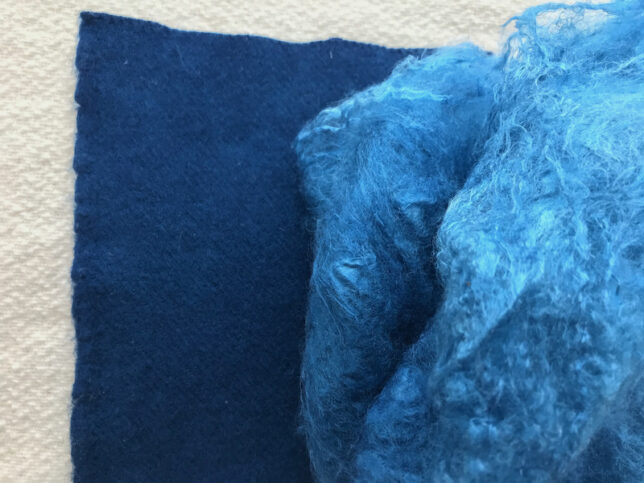
朝、外は零下12度、藍建液温25〜28度、3面ガラスの染場の室温は曇れば7度、晴れれば日中18~20度になる。積雪1m、ガラスの向こうに氷柱、雪が舞う。乳白色のフランス オクシタニー地域産羊毛布を藍建液に浸けると、インジゴが藍還元菌によって還元された水溶性のロイコインジゴにより、緑色に染まる。その布を液から取り出すと、徐々に空気中の酸素で酸化して不溶性のインジゴに変わり、藍色になる。冬は色のコントラストが強い。
In the morning, the outside temperature is -12 degrees Celsius, the indigo liquid temperature is 25 to 28 degrees Celsius, and the room temperature of the dyeing place with glass on three sides is 7 degrees Celsius when it is cloudy and 18-20 degrees Celsius in the daytime when it is sunny. There is 1m of snow outside, and icicles and snow dance behind the glass. Milky white woolen cloth from the Occitanie region of France is dyed green by the water-soluble leuco indigo reduced by indigo reducing bacteria. When the cloth is removed from the indigo liquid, it gradually oxidizes with oxygen in the air and turns into indigo, which turns indigo. Color contrast is strong in winter.

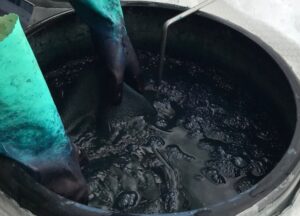
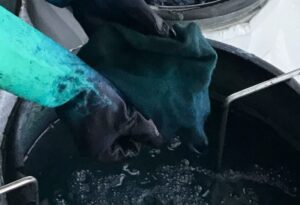
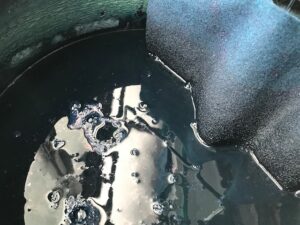
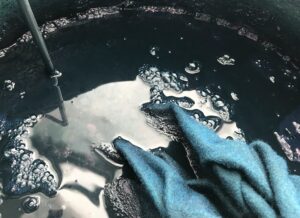
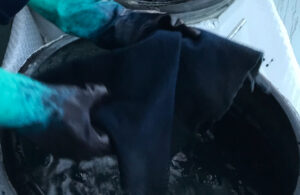
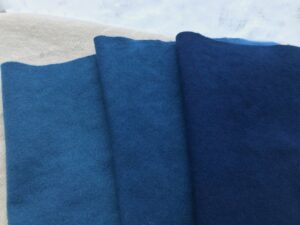
2019年にスコットランドチェビオットやオーストラリアメリノを30kg、2020年に楮作品122cm×122cmを4点を染めたindigo vatで、今回はフィンランド羊毛を染めました。繊細で長毛、オイリーな原毛で、好きな藍色に仕上がりました。
Indigo vat dyed 30 kg of Scottish Cheviot and Australian Merino in 2019, and 4 pieces of 122 cm x 122 cm in 2020, and this time dyed Finnish wool. Delicate, long hair, oily raw wool, finished in my favorite indigo colour.
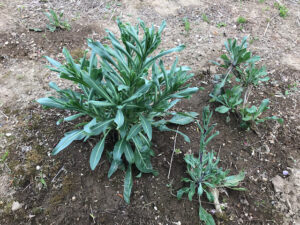
2018年夏収穫の種を播いて、毎年新芽を出して3年目のウォード(ホソバタイセイ)
Woad(Isatis tinctoria) for the third year after sowing seeds harvested in the summer of 2018 and sprout every year
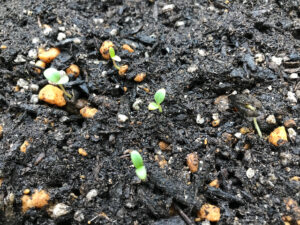
右端は、サヤを被ったままの実生
Seedlings on the far right are covered with seed coat
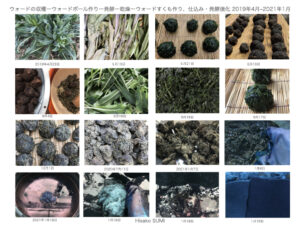
真冬の工房
左:タデアイすくも+小麦麩+木灰汁建て100L
右:ウォードすくも+インド藍靛+小麦麩+木灰汁建100L
Studio in mid winter, 2021/1/14
left:Sukumo+wheat bran+wood ash lye 100L vat
right:couched woad+indigo cake(10% of weight of couched woad)+ wheat bran+wood ash lye 100L vat
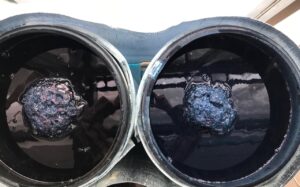
原毛と羊毛布の染め Dyeig raw wool and wool cloth
